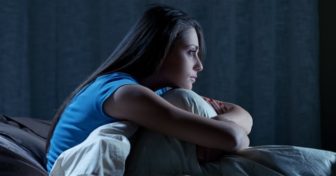Millions of Americans will have a hard time falling or staying asleep tonight, and research says most of them will be women.
“Insomnia is definitely more common in females, and it seems to begin fairly early on,” said Dr. Meir Kryger, a professor at the Yale School of Medicine who studies sleep. Sleep problems can appear in women as early as their teens or 20s, he said.

iStock Photo
Prescription sleep aids are more likely to be used by women than men.
Various research shows women are more likely than men to experience the sleep disorder. Women are about 1.5 times more likely to have insomnia, said Kryger, who has written several books on the topic, including “The Mystery of Sleep,” which was published in March.
A 2006 Canadian study found women are 1.3 to 1.8 times more likely than men to have insomnia, and a 2007 National Sleep Foundation poll of Americans found 60 percent of women ages 18-64 get a good night’s sleep just a few times a week, compared with 52 percent of men.
Amy Nix, 46, of Bethany, has struggled with insomnia since her second child was born 14 years ago. She usually wakes up around 3 or 4 a.m. and can’t get back to sleep, she said.
“I envy those people who can lay down and sleep,” she said.
Women’s greater likelihood of insomnia, Kryger said, is largely due to “tremendous changes in hormonal levels” they experience from the time they begin menstruating through menopause.
“Each one of these is associated with sleep difficulties,” Kryger said. “We know these hormones have an impact on sleep.”
Pregnant women may have trouble sleeping due to increased urination, restless leg syndrome, acid reflux, leg cramps and other discomforts. Women going through menopause often find sleep disturbed by hot flashes and night sweats that can last for years, he said.
Non-hormonal factors can also keep women up at night, said Dr. Daniel McNally, director of the Sleep Disorders Center at UConn Health and a professor at the University of Connecticut School of Medicine.
“More men snore, so more women have to listen to snoring,” he said, which can make falling asleep difficult.
Also, men are more likely to have obstructive sleep apnea, a condition that causes breathing to repeatedly stop and start in sleep. Patients with apnea typically, most of whom are men, have an easier time falling asleep because they are more tired.
Sleep apnea, like insomnia, is a sleep disorder.
More than 18 million adults nationwide have sleep apnea, according to the nonprofit National Sleep Foundation. In people who have it, sleep is briefly and repeatedly interrupted by breathing pauses that last at least 10 seconds, according to the group. It occurs in all age groups and both genders, but is more common in men, particularly men who are middle aged and overweight.
Women, on the other hand, are more likely to have certain ailments or take certain medications that can cause insomnia, Kryger said. Hypothyroidism and depression, for instance, are known to disrupt sleep and are more common among women than men, he added.
“The reasons for the insomnia need to be explored,” he said, and sleep-aid medications should not be the first remedy tried. In many cases, cognitive behavioral therapy, in which patients essentially relearn how to fall asleep, is effective, he added.
Often, people with insomnia come to associate being in bed with being awake, McNally said. Cognitive behavioral therapy trains them to associate bed with sleeping. He encourages patients to get in bed only when they are sleepy and to avoid stimulating activities, like watching an intense television show or reading a book, before bed.
“Lots of people self-medicate with alcohol,” he added. While having a couple of drinks before bed may help people fall asleep faster, it typically leads to poor sleep quality later in the night, he said.
Prescription sleep aids are more likely to be used by women than men, according to the U.S. Centers for Disease Control and Prevention (CDC). About 5 percent of adult women use medications, compared with 3.1 percent of men, according to the CDC.
Nix has tried various medications but to no avail.
“The older I have gotten, the worse it is,” she said. “I have a very difficult time shutting down at night and my mind races. I have been on pretty much every sleep medication on the market from over-the-counter to prescription.”
The National Sleep Foundation’s 2007 study found stay-at-home mothers were the most likely to experience insomnia, with 74 percent saying they had symptoms at least a few nights a week. Also, 72 percent of working mothers and 68 percent of single working women report having insomnia several times a week.
About 6 percent of the overall U.S. population—tens of millions of people—suffer from insomnia, according to the National Institutes of Health.
“This is an extraordinarily common disorder,” McNally said. “Lots of people complain of difficulty getting to sleep and difficulty saying asleep.”